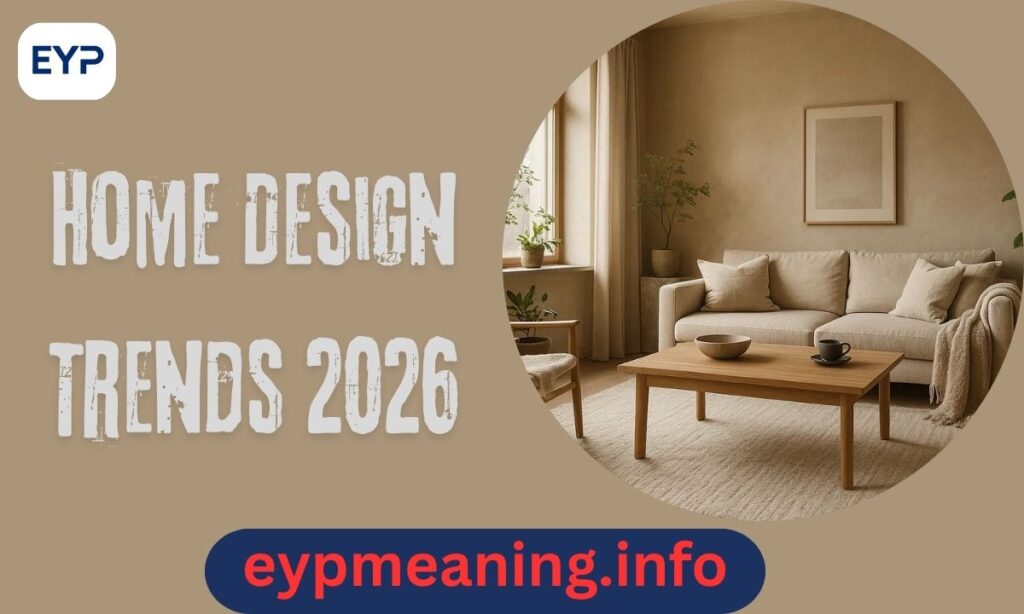The home design landscape is shifting toward warmth, authenticity, and personal well-being in 2026, moving away from the stark minimalism and perfection that dominated previous years. Here are the five key trends designers predict will define next year’s interiors:
1. Wellness Becomes the Heart of the Home
Design is now prioritizing spaces that help people recharge and live better. This means smart lighting systems that support sleep cycles, layouts maximizing natural light, and biophilic design elements like houseplants and organic textures. Home saunas are becoming a top wellness request, reflecting how homeowners want their spaces to actively support their lifestyle and mental health.
2. Earthy Color Drenching and Warm Neutrals Take Over
Crisp white walls are out. The trend is toward warmer, grounded tones like olive, clay, and mushroom, often applied through “color drenching”—painting walls, trim, and ceilings in a single cohesive shade. Warm neutrals are being layered across paints, fabrics, and finishes to create rich, inviting environments. Think soft ivories paired with mid-toned woods for that perpetual golden-hour glow.
3. Natural Woods and Honest Materials Make a Comeback
After years of painted cabinetry dominance, natural wood in medium tones like walnut and mahogany is reclaiming its place. The emphasis is on authentic materials that age gracefully—limewashed plaster, unlacquered metals, and handwoven textiles that develop character and patina over time. It’s about embracing imperfection and choosing quality pieces that improve with age.
4. Curves, Layers and Architectural Softness
Curves aren’t going anywhere. Rounded corners, arched details, and softer furniture silhouettes continue to gain momentum. The approach is “flexibly traditional”—walls remain but are softened with casement openings, glass panel doors, and archways that create flow without fully open concepts. Layered textures and comfortable textiles make spaces inviting rather than just visually impressive.
5. Individuality and Artful Curation Take Center Stage
“Soul over symmetry” is the guiding philosophy. In reaction to mass production and AI, homeowners are embracing handcrafted pieces, vintage finds, and personal collections. The look is artfully curated maximalism—even in neutral spaces—with thrifted items, heirloom furniture, and collected artwork replacing perfectly matched sets. People care more about how their space makes them feel than achieving Instagram-perfect symmetry.
The Bottom Line: 2026 interiors are about creating homes meant to be lived in, not just admired—spaces that feel personal, grounded, and genuinely supportive of well-being.
Retry
A
give me is k related 2500 words me likho 5 Home Design Trends Designers Say Will Be Everywhere in 2026 Wellness Becomes the Heart of the Home Earthy Color Drenching and Warm Neutrals Take Over Natural Woods and Honest Materials Make a Comeback Curves, Layers and Architectural Softness Individuality and Artful Curation Take Center Stage
5 Home Design Trends Designers Say Will Be Everywhere in 2026
The world of interior design is experiencing a profound transformation as we approach 2026. After years of stark minimalism, cold industrial aesthetics, and the pursuit of Instagram-perfect spaces, homeowners and designers alike are embracing a more human-centered approach to creating living environments. This shift represents more than just a change in color palettes or furniture styles—it signals a fundamental reimagining of what our homes should be and how they should make us feel.
The design trends emerging for 2026 reflect a collective desire for authenticity, warmth, and spaces that truly support our well-being. In an increasingly digital and fast-paced world, our homes are becoming sanctuaries where we can disconnect, recharge, and reconnect with what matters most. The following five trends are not merely aesthetic choices but thoughtful responses to how we want to live, work, and find peace in our personal spaces.
Wellness Becomes the Heart of the Home
Perhaps the most significant shift in home design for 2026 is the elevation of wellness from a luxury add-on to a foundational design principle. This transformation has been years in the making, accelerated by our collective experience of spending more time at home and becoming acutely aware of how our living environments impact our physical and mental health.
Today’s wellness-focused design goes far beyond adding a yoga mat in the corner or placing a few plants on a windowsill. Designers are now creating entire ecosystems within homes that actively promote health, relaxation, and vitality. Smart lighting systems that mimic natural circadian rhythms are becoming standard features, helping regulate sleep patterns and boost mood throughout the day. These systems gradually shift from energizing cool tones in the morning to warm, calming hues in the evening, working in harmony with our body’s natural rhythms.
Natural light has become a precious commodity in home design, with architects and designers prioritizing layouts that maximize sunlight exposure. Large windows, strategically placed skylights, and open floor plans that allow light to flow through multiple rooms are no longer just aesthetic choices—they’re wellness interventions. Exposure to natural light has been proven to improve mood, enhance productivity, and support better sleep, making it one of the most valuable features a home can offer.
The concept of biophilic design—integrating nature into our living spaces—continues to flourish and evolve. This goes beyond simply adding houseplants, though those remain important. Designers are incorporating living walls, water features, natural stone elements, and organic textures that create a tangible connection to the natural world. These elements have been shown to reduce stress, improve air quality, and create a sense of calm that’s increasingly difficult to find in our urban environments.
One of the most requested wellness features in luxury homes today is the home sauna. Once considered an extravagant addition, saunas are now being integrated into home gyms and wellness spaces as essential tools for stress relief, detoxification, and relaxation. This trend reflects a broader shift toward viewing our homes as places that actively support our health goals rather than simply providing shelter.
Meditation rooms, dedicated relaxation spaces, and quiet zones designed for digital detox are also gaining popularity. These areas are thoughtfully designed with soft lighting, comfortable seating, and calming colors to create environments where stress naturally melts away. The message is clear: wellness isn’t just about what we do in our homes—it’s about how our homes are designed to support us in living healthier, more balanced lives.
Earthy Color Drenching and Warm Neutrals Take Over
The tyranny of the pristine white wall is finally coming to an end. After decades of stark, bright white interiors that dominated everything from minimalist lofts to farmhouse kitchens, we’re witnessing a dramatic shift toward warmer, more grounded color palettes that feel inherently more welcoming and human.
The technique of color drenching—painting walls, trim, ceilings, and even built-ins in a single cohesive shade—continues to gain momentum, but the colors themselves are evolving. Instead of the bold jewel tones that characterized earlier iterations of this trend, 2026 brings earthier, more sophisticated hues. Think rich olive greens that evoke Mediterranean hillsides, warm clay tones reminiscent of desert sunsets, soft mushroom shades that feel both modern and timeless, and terracotta hues that add warmth without overwhelming.
These colors work because they’re deeply rooted in nature. They’re the shades we see in landscapes, in ancient architecture, in the natural materials that have surrounded humanity for millennia. Unlike trendy colors that can quickly feel dated, these earth tones have a timeless quality that transcends passing fads. They create rooms that feel cocooning and comfortable, spaces where you naturally want to linger.
The warm neutral palette extends beyond paint colors to encompass every element of a room’s design. Fabrics in cream, caramel, sand, and wheat tones are being layered together to create depth and visual interest without relying on bold contrasts. These soft, sun-baked neutrals have a richness that cool grays and stark whites simply cannot match. They catch and reflect natural light in ways that make rooms feel alive and dynamic throughout the day.
Designers are particularly drawn to shades like Sherwin-Williams Agreeable Gray, Gossamer Veil, and Mushroom—colors that read as warm neutrals but have enough depth to create atmosphere. These shades work beautifully as base colors that can be layered with deeper accent tones or allowed to stand alone for a more monochromatic, serene effect.
The goal is to create interiors that perpetually feel like golden hour—that magical time of day when natural light is warmest and most flattering. By pairing soft ivory walls with mid-toned furniture in woods like English oak or walnut, designers are achieving that coveted warm glow that makes spaces feel instantly inviting. This approach to color creates rooms that embrace you rather than intimidate you, homes that feel lived-in and loved from the moment you walk through the door.
Natural Woods and Honest Materials Make a Comeback
For years, painted cabinetry dominated kitchen and bathroom design. White-painted Shaker cabinets became so ubiquitous that they lost all personality, appearing in everything from budget renovations to high-end remodels. But 2026 marks the triumphant return of natural wood, and with it, a renewed appreciation for materials that show their true character.
Medium-toned woods are leading this renaissance. Walnut, with its rich chocolate tones and beautiful grain patterns, is appearing everywhere from kitchen cabinets to bedroom furniture. Mahogany brings a sense of traditional elegance back into contemporary spaces. Oak, particularly English oak with its warm honey tones, is being celebrated for its durability and timeless appeal. These woods aren’t trying to be something they’re not—they’re simply beautiful in their natural state.
This shift toward natural materials represents a broader philosophical change in how we think about our homes. Instead of seeking perfection and uniformity, we’re embracing the variations, the knots in the wood, the subtle color differences that make each piece unique. There’s something deeply satisfying about surrounding yourself with materials that are authentically themselves, that show their history and origins.
The trend toward “honest materials” extends well beyond wood. Limewashed plaster walls, with their soft, matte finish and subtle texture variations, are replacing perfectly smooth drywall. These walls have depth and character; they catch light differently throughout the day and develop a beautiful patina over time. Unlacquered brass and bronze fixtures that age and develop their own unique finish are preferred over perfectly polished metals that require constant maintenance to look new.
Handwoven textiles, natural stone with visible veining, leather that develops character with use—these are the materials defining luxury in 2026. The common thread is authenticity and the beauty of imperfection. These materials tell stories. They age gracefully rather than fighting against time. A leather chair that develops a rich patina, a brass faucet that gradually darkens, a plaster wall that gains character—these aren’t flaws to be prevented but natural processes to be celebrated.
This embrace of materials with patina makes homes feel genuinely lived-in and real. There’s a sense of relaxation that comes with knowing your home will actually look better as it ages, that you don’t need to worry about maintaining impossible standards of newness. Quality over quantity becomes the guiding principle—choosing fewer, better pieces that will serve you for decades rather than trendy items that need replacing every few years.
Curves, Layers and Architectural Softness
The reign of hard edges and severe angles is softening. Curves, which began gaining popularity a few years ago, have proven themselves to be far more than a passing trend. In 2026, rounded corners, arched doorways, and furniture with gentle, flowing lines are defining the aesthetic of thoughtfully designed homes.
This movement toward curves represents a rejection of the cold, industrial aesthetic that dominated the 2010s. Sharp corners and hard edges create visual tension; curves provide visual relief. A rounded sofa invites you to sink in and get comfortable in a way that a severely angular one simply doesn’t. An arched doorway creates a sense of journey and discovery as you move through a home. Rounded mirrors, curved lighting fixtures, and furniture with soft silhouettes all contribute to creating spaces that feel inherently more welcoming and human-scale.
The architectural application of curves is particularly exciting. Designers are moving away from the completely open floor plan—which often left homes feeling like echo chambers without definition—toward what’s being called “flexibly traditional” design. Walls aren’t disappearing entirely, but they’re being softened and made more permeable through casement openings, glass panel doors, and graceful archways.
These architectural elements create a sense of flow while still maintaining distinct spaces with their own character and purpose. You can have a sense of connection between rooms without sacrificing all privacy and sound separation. An arched opening between a kitchen and dining room creates visual connection while maintaining spatial definition. Glass panel doors allow light to flow between spaces while providing the option to close off areas when needed.
Lighting design is also becoming more subtle and layered. The era of oversized “statement” chandeliers that scream for attention is giving way to more understated fixtures that let the materials and the quality of light itself take center stage. Multiple light sources at different heights and intensities create depth and atmosphere, allowing rooms to transform from bright and energizing to soft and intimate depending on the time of day and desired mood.
The key to this trend is layering—not just of light, but of textures, fabrics, and furnishings. Think of a room with linen curtains that soften hard windows, velvet cushions that invite touch, a chunky knit throw draped over a curved sofa, and a plush area rug that grounds the space. Each layer adds another dimension of comfort and visual interest. The goal is to create environments so inviting that you can’t help but want to sink in, kick off your shoes, and stay awhile.
Individuality and Artful Curation Take Center Stage
Perhaps the most refreshing trend for 2026 is the decisive rejection of cookie-cutter interiors in favor of spaces that reflect the genuine personality and history of the people who live in them. In a world increasingly dominated by mass production and artificial intelligence, the desire for authenticity and individuality in our living spaces has never been stronger.
The trifecta of “individual, handcrafted, and vintage” is defining how people approach furnishing and decorating their homes. Rather than buying complete room sets from a single retailer, homeowners are mixing heirloom pieces inherited from family with carefully selected vintage finds, custom-made furniture, and contemporary pieces that speak to them personally. The result is spaces that feel collected over time rather than bought all at once.
This approach requires patience and a willingness to hunt for the right pieces. A perfect vintage lamp found at a flea market carries more meaning than a new one ordered online. A custom-made dining table from a local craftsperson becomes a conversation piece and a family legacy. Even choosing to mix rather than match dining chairs—perhaps combining a few inherited pieces with some vintage finds—creates visual interest and tells a story about who you are and what you value.
The concept of “soul over symmetry” perfectly captures this trend. Traditional design rules about balance and matching are being thrown out in favor of arrangements that simply feel right. A gallery wall doesn’t need to be perfectly symmetrical—in fact, it’s often more interesting when it’s not. Collected artwork, family photos, children’s drawings, and treasured prints can coexist in a way that feels personal and evolving rather than designed by a professional in a single afternoon.
Artful maximalism is making its presence felt, even in spaces that maintain a relatively neutral base. This doesn’t mean cluttered chaos—it means carefully curated collections displayed with intention. A shelf of interesting pottery, a wall of framed botanical prints, a collection of vintage cameras—these personal collections add layers of interest and personality that no amount of perfectly matched decor can achieve.
This trend is partly a reaction against the sameness of social media design. When everyone’s home looks like it came from the same Pinterest board, the desire to create something genuinely unique becomes powerful. People are recognizing that the homes that stick in our memory are the ones with character, with stories, with unexpected elements that reflect the specific tastes and experiences of their inhabitants.
Conclusion
What unites all five of these trends is a fundamental shift in priorities. The homes of 2026 aren’t designed to impress visitors or photograph well for social media—though they may do both. Instead, they’re designed to support the actual, daily lives of the people who live in them. They prioritize comfort over formality, authenticity over perfection, and well-being over trends.
This represents a maturation of design thinking. We’ve moved past the need to prove our taste through our homes and into a place where we can simply create environments that serve us well. The recognition that our homes profoundly impact our mental and physical health has elevated design from a purely aesthetic pursuit to something more meaningful and essential.






